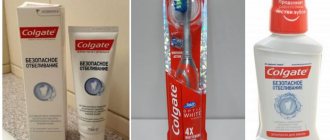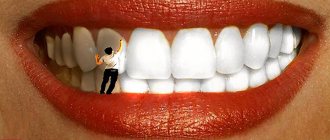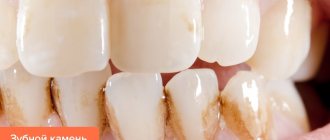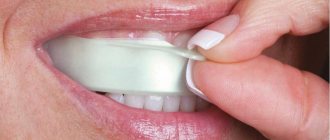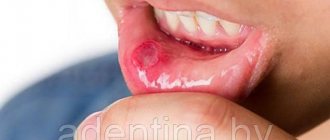- Why does enamel darken?
- Frequent mistakes and misconceptions
- How to remove stubborn plaque? Mechanical
- Enzymatic
- Light
- Toothpastes with peroxides
There are many misconceptions associated with whitening: some believe that it damages the enamel, others that it only works in the dentist’s chair. In fact, you can safely lighten your teeth several shades at home, without any medical skills. Today we will talk about the nature of enamel darkening and the means by which you can whiten your teeth without harm.
Why does enamel darken?
Typically, the enamel has a yellowish tint, close to milky white. But it should not be confused with the acquired yellowish color of teeth. Everyone's teeth darken - doctors call this discoloration, and it appears for various reasons. Darkenings are divided into two categories:
- external - appear on the surface of the tooth;
- internal - associated with the condition of dentin and pulp.
External darkening can become internal. This occurs when pigments penetrate the dentin through chips and cracks in the enamel.
External staining is caused by a hard pigment deposit that accumulates on the enamel. Most often it appears due to smoking, poor hygiene, consumption of products with natural or artificial colors (coffee, tea, red wine, sauces, etc.).
Internal staining occurs for the following reasons:
- excess fluoride in the body;
- hereditary diseases of hard dental tissues;
- caries;
- taking antibiotics and iron-containing drugs.
External darkening is removed with abrasive or enzymatic pastes, and internal darkening is removed with products containing peroxides.
Composition of whitening gels
Teeth whitening gel contains hydrogen peroxide, which reacts chemically with pigments and causes its destruction. With the help of such products, you can successfully cope with the darkening of the enamel caused by smoking, frequent consumption of coffee, tea and other products that can stain the crowns of teeth. The products differ in the content of the active component.
The concentration can vary between 4-7.5%. As a rule, the hydrogen peroxide content in home remedies is not high, but professional formulations are more active. This is due to the fact that hydrogen peroxide can be harmful if it comes into contact with mucous membranes. When it is necessary to remove slight darkening, gels containing urea can be used. It has an abrasive effect, but is safe for teeth.
Frequent mistakes and misconceptions
Before you begin enamel whitening, you need to treat your teeth for caries, relieve gum inflammation, if any, and also remove plaque - with highly abrasive pastes or in the chair of a dental hygienist. If there is plaque on the teeth, whitening procedures will not give the desired result.
You need to understand that not a single toothpaste will whiten yellowish teeth to snow-white ones in a couple of uses. To determine the color of tooth enamel, the Vita scale is used - it has 16 shades, divided into 4 groups. The Vita scale is used during whitening to determine the shade of teeth at the initial stage and observe how it changes as a result of the procedure.
Teeth whitening is not recommended for teenagers whose enamel and other tooth tissues are still developing. Whitening with peroxides should not be carried out during pregnancy and breastfeeding.
How to remove stubborn plaque?
Abrasives
You can lighten your teeth using highly abrasive pastes. From 10% to 50% of the volume of such pastes is occupied by abrasives - hard polishing particles, with the help of which plaque and food debris are removed.
The cleaning and polishing properties of toothpaste depend on the concentration of abrasive particles, their size, shape and hardness. Silicon dioxide, calcium carbonate (chalk), sodium metaphosphate and even diamond dust are used as abrasives in pastes.
In dentistry, a single standard has been adopted for assessing the abrasiveness of hygiene products and their impact on enamel - the RDA (Relative Dentin Abrasivity) abrasivity index, where:
- 0–30 – low abrasiveness;
- 30–80 – moderate abrasiveness;
- 80–150 – high abrasiveness;
- >150 - polishing pastes for use no more than 1-2 times a week.
Pastes with high abrasiveness clean more intensively and are suitable for smokers and coffee lovers.
It is better to use such pastes in cycles or alternate with strengthening ones, otherwise you can injure the enamel. If you have sensitive teeth, chips and cracks in the enamel, highly abrasive toothpastes will not be suitable. Pastes with low and medium abrasiveness can be used every day. They often add additional bleaching agents - enzymes or peroxides.
Marvis Whitening Mint Toothpaste Whitening 85 ml
Toothpaste Apagard Smokin 100 ml
ApaCare Polish Polishing Toothpaste
ISME RasYan Herbal Clove Polishing Toothpaste
Enzymes
You can carefully and safely lighten enamel with pastes containing plant components - enzymes and extracts. They break down and loosen plaque, making it easier to remove. Such pastes have a low level of abrasiveness, which means they are safer for enamel. Enzymes are obtained from fruits: bromelain - from pineapple, papain - from papaya. You can brush your teeth with such pastes every day, even with sensitive enamel.
Yotuel Whitening Pharma toothpaste
Tooth cream SWISSDENT CRYSTAL (50 ml)
Toothpaste ROCS (ROCS) PRO Delicate whitening Sweet mint
Blanx Pro Pure White Toothpaste Pure white
Light
Lightening due to blue particles and pigments. Tooth enamel is able to absorb, reflect and scatter light, which affects its visible shade. Pastes containing blue particles, or pigments, create the optical illusion of whiteness. The blue undertone visually removes yellowness - this effect is used in detergents for white laundry. Such pastes give a short-term effect, because the pigments work only on the surface.
As a rule, pastes with pigments have a low or medium level of abrasiveness, since the emphasis is on the coloring effect. There are no contraindications for such pastes.
Blanx Pro Pure White Toothpaste Pure white
Blanx White Shock toothpaste 50 ml with activator lamp
Teeth whitening with peroxides
Visible and long-lasting results can be achieved with pastes containing peroxides. Home whitening systems and everyday products contain the same substances as professional ones, but in lower concentrations.
The active ingredients of such products are hydrogen peroxide and carbamide peroxide. They work the same way: they disintegrate on the teeth and form atomic oxygen. It gets into the pores of the enamel and oxidizes colored pigments, including colored dentin. As a result, the pigments become discolored and the teeth become whiter.
The difference between hydrogen peroxide and carbamide peroxide is that carbamide peroxide works more slowly. During cleaning, it begins to break down into hydrogen peroxide and urea peroxide, and only then oxygen atoms are released. And hydrogen peroxide immediately begins to decompose with the release of atomic oxygen. Therefore, products based on carbamide peroxide whiten more carefully and are less likely to cause allergies.
Toothpastes with peroxides
Toothpastes with peroxides do not contain harsh abrasives because the focus is on chemical whitening. They often contain fluorides and xylitol, which fight caries and strengthen teeth, so such pastes can be used even with increased tooth sensitivity. But if there is serious damage to the enamel or irritation of the gums, it is better to use more gentle means - for example, enzymatic lightening pastes.
Yotuel All in One Snowmint Toothpaste
SWISSDENT EXTREME toothpaste (50 ml)
Nano WhiteWash Intensive Whitening Toothpaste
Dr.EL Tooth Whitening Toothpaste Whitening
Whitening strips with peroxides
Whitening strips contain hydrogen peroxide, so they are more intense than toothpastes. They are used in a course of 5 to 14 days. The number of strips in a pack is for 1 course. The strip should be kept on the teeth for about 30 minutes 1 or 2 times a day, and the result will be noticeable after the first use.
The disadvantage of strips is that the whitening composition does not always penetrate into the spaces between teeth, and these places may turn out to be darker than the front side of the teeth. These areas can be corrected with whitening pencils and pens.
In addition, the strips touch the mucous membranes, so they cannot be used for sensitive gums. The second contraindication is any enamel defects (cracks, chips, non-carious lesions, caries).
Bright Light Professional Effects daytime strips
Bright Light Night Effects Strips
Strips MEGAMI WHITE XTREME 3D PRO
MEGAMI WHITE XTREME 3D PRO strips for sensitive teeth
Whitening pens and pens with peroxides
Whitening pencils and pens also contain peroxide-based gel, but its concentration is higher than in strips. They are suitable for spot whitening of interdental spaces or darker teeth, such as fangs.
These products will help if you need to quickly whiten your teeth before an important event. The pencils are convenient to take with you, and the effect is noticeable after 15 minutes. You can use them 2 to 4 times a day. The amount of gel is calculated for a monthly course. Pencils, like strips, cannot be used for problems with enamel and gums.
Whitening systems with peroxides
Whitening systems with trays - removable plastic structures - can be classified as professional whitening products. Unlike pencils and strips, the active substance in them is carbamide peroxide. Fluorides can often be seen in the composition. The percentage of peroxides is from 10% to 20%.
In systems that involve wearing mouthguards with a special gel, carbamide peroxide is used instead of hydrogen peroxide, because the gel somehow gets on the mucous membranes, and this can cause a chemical burn. The mouth guards usually need to be worn for an hour every day for 5 to 14 days.
Yotuel 7 Hours
Opalescence PF 10% Patient Kit (8 syringes)
Opalescence PF 15% Patient Kit (8 syringes)
Opalescence PF 20% Patient Kit (8 syringes)
Hardware whitening method: main stages and features of the procedure
Due to the speed of the procedure and a noticeable long-term effect, the hardware method of teeth whitening is popular not only among dentists, but also among patients. But technology alone is not enough for a good result. The specialist must strictly follow the instructions for using the equipment, take into account possible contraindications for a particular patient and flawlessly perform all stages of whitening. The procedure for hardware teeth whitening using the example of the American BEYOND™ system is in a new review by Dental Magazine.
Preparation for the procedure
Conduct a preliminary examination of the patient's oral cavity and find out from him what result he expects to receive. It is important to remember that before undergoing a whitening procedure in a dental office, the patient must review and sign the “Informed Consent for the Whitening Procedure.” This service belongs to the category of aesthetic procedures, and the dentist, despite the impeccable performance of all stages of whitening, cannot guarantee the achievement of a specific result. A well-drafted informed consent document will help the doctor avoid unfounded claims. When determining the shade of enamel before and after the procedure, use the color chart.
Notes and contraindications
- The procedure is not recommended for pregnant or breastfeeding women and patients under 16 years of age.
- For 24 hours after the procedure, patients should avoid eating or drinking foods that contain coloring agents. Cigarette use should also be limited.
- Depending on the patient's diet, oral hygiene, and smoking habits, maintenance procedures may be necessary to maintain the results.
- If tooth sensitivity occurs after the procedure, recommend the patient to use analgesics
- After completing the procedure, do not forget to give the patient a reminder about caring for teeth after whitening.
- A contraindication for the use of whitening gel is if the patient has an allergic reaction or chemical sensitivity to peroxides or glycols.
Storage and contents
Store all contents of the whitening kit in a cool, dry place. Avoid direct sunlight. Syringes with BEYOND II Advanced Formula Whitening Gel should be stored at a temperature of approximately 5 0C.
1. Apply barrier cream to the patient's lips and insert a buccal retractor. Advise that it is safe to swallow saliva.
2. Protect the face area around the outside of the cheek retractor with a tissue. Determine the existing shade of tooth enamel. Wear safety glasses to the patient. Brush your teeth with a polishing paste containing particles of pumice or polishing sand. Place cotton rolls on either side of the cheek bands. Additionally, apply a protective product to the inner surfaces of the upper and lower lips.
3. Dry your teeth and gums. Moisture can prevent the gums from sealing completely. Apply protective light-curing liquid dental dam to gums. The rubber dam should seal the gum pockets and bridge the gingival sulcus. Any wedge-shaped defects or enamel chips should also be isolated with a liquid rubber dam to avoid postoperative sensitivity in these areas.
4. Initiate its light curing using a circular motion of the curing lamp. When exposing the rubber dam, do not keep the curing lamp in one place, since heating from the lamp may cause discomfort to the patient. It is not recommended to use liquid rubber dam in patients with known resin sensitivity. If dermatitis, rash or any other allergic reaction occurs, rinse the area where the drug is applied with a strong stream of water and refer the patient to a physician.
5. Attach the mixing tip to the dual-barrel whitening gel syringe and apply a 2-3 mm thick layer of BEYOND™ II Advanced Formula Whitening Gel to the dry surface of the teeth. Do not allow the whitening gel to come into contact with the patient's gums or mouth. If the whitening gel gets on the patient's gums during the procedure, the pink color of the gums may temporarily change to white. This should not be a cause for concern as your gums will return to their natural color within a few hours of completion of the procedure.
6. Position the accelerator lamp at a 90° angle to the surface of the teeth and press the Start/Stop button to begin the 10-minute whitening cycle. At the end of the 10-minute cycle, use a saliva ejector to remove the whitening gel. Do not wash off the gel with water. Repeat steps 6-8 two more times (for a total of three 10-minute cycles). Interrupt the whitening procedure if the patient reports severe tooth sensitivity and remove all whitening gel before applying the fluoride gel.
7. After the final cycle, completely remove the whitening gel with a saliva ejector, remove the liquid dental dam and wipe the teeth clean with cotton swabs or gauze swabs. Apply sodium fluoride gel to your teeth and leave on for one minute. At the end of the procedure, remove the fluoride gel using a saliva ejector, remove the protective tissue, cheek retractors, cotton rolls, and ask the patient to rinse the mouth thoroughly. The rinse water should be warm. Show the patient the new shade of teeth.
How to maintain the effect after home whitening
Just like after professional whitening, your teeth will need special care.
- For 10–14 days after the procedure, follow a white diet. Eliminate from your diet food and drinks with natural and synthetic dyes - colored vegetables and fruits, tea, coffee, wine, as well as foods with acids. Acids are found in citrus fruits and sweet sodas - they soften the enamel, making it more vulnerable to pigments. Drink coloring drinks only through a straw.
- If you do drink or eat something colored, rinse your mouth with mouthwash or at least plain water.
- Maintain hygiene, do not forget about dental floss and brushes.
- After whitening, use remineralizing pastes that will strengthen the enamel and protect it from exposure to food acids.
Special toothpastes
This is the most affordable way to whiten teeth at home. As a rule, these pastes contain abrasive particles that remove plaque and polish the enamel, making it lighter.
The main advantage of all home whitening methods is that they are affordable. But with their help, it will be possible to lighten the enamel by no more than 2–3 tones, and to maintain this effect, the procedures will have to be repeated with enviable regularity.
Important to remember!
Uncontrolled use of home teeth whitening methods can damage the enamel and cause its thinning. In addition, all of them, like professional methods, have their contraindications and require prior consultation with a dentist.
